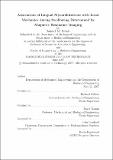Association of lingual myoarchitecture with local mechanics during swallowing determined by magnetic resonance imaging
Author(s)
Felton, Samuel M., M. Eng. Massachusetts Institute of Technology
DownloadFull printable version (7.544Mb)
Advisor
Richard Gilbert and Roger Kamm.
Terms of use
Metadata
Show full item recordAbstract
The tongue is an intricately configured muscular organ, which undergoes a series of rapid shape changes intended to first configure and then transport the bolus from the oral cavity to the pharynx during swallowing. In order to observe the synergistic interactions of the eight different muscles in the tongue, MRI techniques were used to determine the three-dimensional fiber architecture, measure the mechanical function of the tongue during swallow, and relate the two quantitatively to identify fiber contraction. Diffusion Tensor Imaging was applied to the in vivo tongue of five subjects at rest to image the tongue myoarchitecture. The data revealed the complex relationships between extrinsic and intrinsic fibers. Phase Contrast MRI was applied to ten subjects to assess the complex array of mechanical events occurring during the propulsive phase of swallowing. Physiological strain rate data was acquired in 4 and 6 time point series during approximately 3 ml water bolus swallows. Data acquisition was gated to pressure from the tip of the tongue against the hard palate, indicating the beginning of the irreversible late accommodation. This method demonstrated that the propulsive phase of swallowing is associated with a precisely organized series of compressive and expansive strain rate events. Individual subject data sets from both of these methods were then related. The alignment between local fiber direction and the co-located strain rate tensor was quantified by the dot product between the two vectors. Using this technique, the sagittal muscle activity was observed over the course of the swallow. In the first 200 ms after gating, the verticalis and palatoglossus contract in order to form the bolus. (cont.) From 300-400 ms, the genioglossus contracts, opening the bolus into the throat, while the verticalis and geniohyoid relax. at 500 ms, relaxation throughout the tongue occurs. These data support the concept that propulsive lingual deformation is due to complex muscular interactions involving both extrinsic and intrinsic muscles.
Description
Thesis (M. Eng.)--Massachusetts Institute of Technology, Biological Engineering Division; and, (S.B.)--Massachusetts Institute of Technology, Dept. of Mechanical Engineering, June 2007. This electronic version was submitted by the student author. The certified thesis is available in the Institute Archives and Special Collections. Includes bibliographical references (p. 131-135).
Date issued
2007Department
Massachusetts Institute of Technology. Department of Biological Engineering; Massachusetts Institute of Technology. Department of Mechanical EngineeringPublisher
Massachusetts Institute of Technology
Keywords
Biological Engineering Division., Mechanical Engineering.